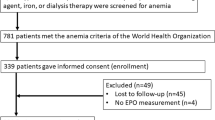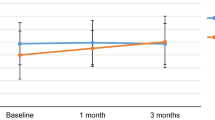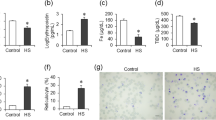Abstract
Anemia is one of the world's most common preventable conditions, yet it is often overlooked, especially in people with diabetes mellitus. Diabetes-related chronic hyperglycemia can lead to a hypoxic environment in the renal interstitium, which results in impaired production of erythropoietin by the peritubular fibroblasts and subsequent anemia. Anemia in patients with diabetes mellitus might contribute to the pathogenesis and progression of cardiovascular disease and aggravate diabetic nephropathy and retinopathy. Anemia occurs earlier in patients with diabetic renal disease than in nondiabetic individuals with chronic kidney disease. Although erythropoietin has been used to treat renal anemia for nearly two decades, debate persists over the optimal target hemoglobin level. Most guidelines recommend that hemoglobin levels be maintained between 105g/l and 125g/l. The suggested role of anemia correction—to prevent the progression of left ventricular hypertrophy in patients with diabetes mellitus—is yet to be established. However, an emphasis on regular screening for anemia, alongside that for other diabetes-related complications, might help to delay the progression of vascular complications in these patients.
Key Points
-
Anemia is a common complication of diabetes mellitus and an independent contributor to the pathogenesis and progression of other diabetes-related complications
-
Erythropoietic stress in diabetes mellitus might be caused by elevated levels of advanced glycation end products, oxidative stress, endothelial dysfunction, abnormal red blood cells and reduced bioavailability of nitric oxide
-
Anemia occurs earlier in patients with diabetic nephropathy than in nondiabetic individuals with comparable renal function
-
In patients with diabetes mellitus, correction of anemia improves quality of life and might delay the progression of diabetic complications; therefore, routine screening for anemia is recommended in this population
-
Until definitive evidence of optimal hemoglobin levels is available, treatment should aim to achieve levels of 105g/l–125g/l
This is a preview of subscription content, access via your institution
Access options
Subscribe to this journal
Receive 12 print issues and online access
$209.00 per year
only $17.42 per issue
Buy this article
- Purchase on Springer Link
- Instant access to full article PDF
Prices may be subject to local taxes which are calculated during checkout


Similar content being viewed by others
References
King, H., Aubert, R. E. & Herman, W. H. Global burden of diabetes, 1995–2025: prevalence, numerical estimates, and projections. Diabetes Care 21, 1414–1431 (1998).
Jonsson, B. Revealing the cost of type II diabetes in Europe. Diabetologia 45, S5–S12 (2002).
World Health Organ. Nutritional anaemias. Report of a WHO scientific group. Tech. Rep. Ser. 405, 5–37 (1968).
Thomas, M. C., Macisaac, R. J., Tsalamandris, C., Power, D. & Jerums, G. Unrecognized anemia in patients with diabetes: a cross-sectional survey. Diabetes Care 26, 1164–1169 (2003).
Sarnak, M. J. et al. Anemia as a risk factor for cardiovascular disease in the Atherosclerosis Risk In Communities (ARIC) study. J. Am. Coll. Cardiol. 40, 27–33 (2002).
Silverberg, D. S. et al. The effect of correction of anaemia in diabetics and nondiabetics with severe, resistant, congestive heart failure and chronic renal failure by subcutaneous erythropoietin and intravenous iron. Nephrol. Dial. Transplant. 18, 141–146 (2003).
Keane, W. F. et al. The risk of developing end-stage renal disease in patients with type 2 diabetes and nephropathy: the RENAAL study. Kidney Int. 63, 1499–1507 (2003).
Sinclair, S. H. Macular retinal capillary hemodynamics in diabetic patients. Ophthalmology 98, 1580–1586 (1991).
Lameire, N. The anaemia of silent diabetic nephropathy—prevalence, psysiopathology, and management. Acta Clin. Belg. 58, 159–168 (2003).
Thomas, M. C., Cooper, M. E., Rossing, K. & Parving, H. H. Anaemia in diabetes: is there a rationale to TREAT? Diabetologia 49, 1151–1157 (2006).
Lundin, A. P. Quality of life: subjective and objective improvements with recombinant human erythropoietin therapy. Semin. Nephrol. 9, 22–29 (1989).
Kausz, A. T., Obrador, G. T. & Pereira, B. J. Anemia management in patients with chronic renal insufficiency. Am. J. Kidney Dis. 36, S39–S51 (2000).
Jungers, P. et al. Beneficial influence of recombinant human erythropoietin therapy on the rate of progression of chronic renal failure in predialysis patients. Nephrol. Dial. Transplant. 16, 307–312 (2001).
Bosman, D. R., Winkler, A. S., Marsden, J. T., Macdougall, I. C. & Watkins, P. J. Anemia with erythropoietin deficiency occurs early in diabetic nephropathy. Diabetes Care 24, 495–499 (2001).
Grossmann, M. et al. Low testosterone and anaemia in men with type 2 diabetes. Clin. Endocrinol. [doi:10.1111/j.1365-2265.2008.03357] (Oxf.) (2008).
US Renal Data System. USRDS 2002 Annual Data Report: Atlas of End-Stage Renal Disease in the United States. National Institutes of Health, National Institute of Diabetes and Digestive and Kidney Diseases, Bethesda MD. 2001. Ref. Type: Report.
Chandra, M., Clemons, G. K. & McVicar, M. I. Relation of serum erythropoietin levels to renal excretory function: evidence for lowered set point for erythropoietin production in chronic renal failure. J. Pediatr. 113, 1015–1021 (1988).
Radtke, H. W. et al. Serum erythropoietin concentration in chronic renal failure: relationship to degree of anemia and excretory renal function. Blood 54, 877–884 (1979).
Basturk, T. et al. Urinary N.-acetyl B glucosaminidase as an earlier marker of diabetic nephropathy and influence of low-dose perindopril/indapamide combination. Ren. Fail. 28, 125–128 (2006).
Catalano, C., Winocour, P. H., Gillespie, S., Gibb, I. & Alberti, K. G. Effect of posture and acute glycaemic control on the excretion of retinol-binding protein in normoalbuminuric insulin-dependent diabetic patients. Clin. Sci. (Lond.) 84, 461–467 (1993).
Jones, S. C., Saunders, H. J. & Pollock, C. A. High glucose increases growth and collagen synthesis in cultured human tubulointerstitial cells. Diabet. Med. 16, 932–938 (1999).
Allen, D. A., Harwood, S., Varagunam, M., Raftery, M. J. & Yaqoob, M. M. High glucose-induced oxidative stress causes apoptosis in proximal tubular epithelial cells and is mediated by multiple caspases. FASEB J. 17, 908–910 (2003).
Phillips, A. O., Topley, N., Steadman, R., Morrisey, K. & Williams, J. D. Induction of TGFβ1 synthesis in D-glucose primed human proximal tubular cells by IL-1-β and TNF-α. Kidney Int. 50, 1546–1554 (1996).
Choi, Y. J. et al. Peritubular capillary loss is associated with chronic tubulointerstitial injury in human kidney: altered expression of vascular endothelial growth factor. Hum. Pathol. 31, 1491–1497 (2000).
Palm, F. Intrarenal oxygen in diabetes and a possible link to diabetic nephropathy. Clin. Exp. Pharmacol. Physiol. 33, 997–1001 (2006).
Komers, R. & Anderson, S. Paradoxes of nitric oxide in the diabetic kidney. Am. J. Physiol. Renal Physiol. 284, F1121–F1137 (2003).
Palm, F. et al. Polyol-pathway-dependent disturbances in renal medullary metabolism in experimental insulin-deficient diabetes mellitus in rats. Diabetologia 47, 1223–1231 (2004).
Epstein, F. H., Agmon, Y. & Brezis, M. Physiology of renal hypoxia. Ann. N. Y. Acad. Sci. 718, 72–81 (1994).
Higgins, D. F. et al. Hypoxic induction of CTGF is directly mediated by HIF-1. Am. J. Physiol. Renal Physiol. 287, F1223–F1232 (2004).
Iyer, N. V. et al. Cellular and developmental control of O2 homeostasis by hypoxia-inducible factor 1α. Genes Dev. 12, 149–162 (1998).
Carmeliet, P. et al. Role of HIF-1α in hypoxia-mediated apoptosis, cell proliferation and tumour angiogenesis. Nature 394, 485–490 (1998).
Maxwell, P. HIF-1: an oxygen response system with special relevance to the kidney. J. Am. Soc. Nephrol. 14, 2712–2722 (2003).
Catrina, S. B., Okamoto, K., Pereira, T., Brismar, K. & Poellinger, L. Hyperglycemia regulates hypoxia-inducible factor-1α protein stability and function. Diabetes 53, 3226–3232 (2004).
Bosman, D. R. et al. Erythropoietin response to hypoxia in patients with diabetic autonomic neuropathy and nondiabetic chronic renal failure. Diabet. Med. 19, 65–69 (2002).
Symeonidis, A. et al. Inappropriately low erythropoietin response for the degree of anemia in patients with noninsulin-dependent diabetes mellitus. Ann. Hematol. 85, 79–85 (2006).
Thomas, M. C., Tsalamandris, C., MacIsaac, R. & Jerums, G. Functional erythropoietin deficiency in patients with type 2 diabetes and anaemia. Diabet. Med. 23, 502–509 (2006).
Craig, K. J. et al. Anemia and diabetes in the absence of nephropathy. Diabetes Care 28, 1118–1123 (2005).
Dikow, R., Schwenger, V., Schomig, M. & Ritz, E. How should we manage anaemia in patients with diabetes? Nephrol. Dial. Transplant. 17 (Suppl. 1), 67–72 (2002).
Macdougall, I. C. & Cooper, A. C. Erythropoietin resistance: the role of inflammation and pro-inflammatory cytokines. Nephrol. Dial. Transplant. 17 (Suppl. 11), 39–43 (2002).
Means, R. T., Jr & Krantz, S. B. Progress in understanding the pathogenesis of the anemia of chronic disease. Blood 80, 1639–1647 (1992).
Dai, C. H., Price, J. O., Brunner, T. & Krantz, S. B. Fas ligand is present in human erythroid colony-forming cells and interacts with Fas induced by interferon γ to produce erythroid cell apoptosis. Blood 91, 1235–1242 (1998).
Kirstein, M. et al. Advanced protein glycosylation induces transendothelial human monocyte chemotaxis and secretion of platelet-derived growth factor: role in vascular disease of diabetes and aging. Proc. Natl Acad. Sci. USA 87, 9010–9014 (1990).
Miller, J. A., Gravallese, E. & Bunn, H. F. Nonenzymatic glycosylation of erythrocyte membrane proteins. Relevance to diabetes. J. Clin. Invest. 65, 896–901 (1980).
Hangaishi, M. et al. Increased aggregation of human platelets produced by advanced glycation end products in vitro. Biochem. Biophys. Res. Commun. 248, 285–292 (1998).
Bucala, R. & Vlassara, H. Advanced glycosylation end products in diabetic renal and vascular disease. Am. J. Kidney Dis. 26, 875–888 (1995).
Boel, E., Selmer, J., Flodgaard, H. J. & Jensen, T. Diabetic late complications: will aldose reductase inhibitors or inhibitors of advanced glycosylation end product formation hold promise? J. Diabetes Complications 9, 104–129 (1995).
Schnackenberg, C. G. Physiological and pathophysiological roles of oxygen radicals in the renal microvasculature. Am. J. Physiol. Regul. Integr. Comp. Physiol. 282, R335–R342 (2002).
Buerk, D. G. Can we model nitric oxide biotransport? A survey of mathematical models for a simple diatomic molecule with surprisingly complex biological activities. Annu. Rev. Biomed. Eng. 3, 109–143 (2001).
Saltzman, M. B. & McCallum, R. W. Diabetes and the stomach. Yale J. Biol. Med. 56, 179–187 (1983).
Marrollo, M. et al. Increased prevalence of Helicobacter pylori in patients with diabetes mellitus. Dig. Liver Dis. 33, 21–29 (2001).
De Block, C. E. et al. Soluble transferrin receptor level: a new marker of iron-deficiency anemia, a common manifestation of gastric autoimmunity in type 1 diabetes. Diabetes Care 23, 1384–1388 (2000).
Treem, W. R. Emerging concepts in celiac disease. Curr. Opin. Pediatr. 16, 552–559 (2004).
Weiss, G. & Goodnough, L. T. Anemia of chronic disease. N. Engl. J. Med. 352, 1011–1023 (2005).
Horl, W. H. Non-erythropoietin-based anaemia management in chronic kidney disease. Nephrol. Dial. Transplant. 17 (Suppl. 11), 35–38 (2002).
Thomas, M. C., Macisaac, R. J., Tsalamandris, C. & Jerums, G. Elevated iron indices in patients with diabetes. Diabet. Med. 21, 798–802 (2004).
Fujimoto, S., Kawakami, N. & Ohara, A. Nonenzymatic glycation of transferrin: decrease of iron-binding capacity and increase of oxygen radical production. Biol. Pharm. Bull. 18, 396–400 (1995).
Ting, R. Z., Szeto, C. C., Chan, M. H., Ma, K. K. & Chow, K. M. Risk factors of vitamin B12 deficiency in patients receiving metformin. Arch. Intern. Med. 166, 1975–1979 (2006).
Wagstaff, A. J. & Goa, K. L. Rosiglitazone: a review of its use in the management of type 2 diabetes mellitus. Drugs 62, 1805–1837 (2002).
Ishani, A. et al. Angiotensin-converting enzyme inhibitor as a risk factor for the development of anemia, and the impact of incident anemia on mortality in patients with left ventricular dysfunction. J. Am. Coll. Cardiol. 45, 391–399 (2005).
Robles, N. R., Angulo, E., Grois, J. & Barquero, A. Comparative effects of fosinopril and irbesartan on hematopoiesis in essential hypertensives. Ren. Fail. 26, 399–404 (2004).
Virtue, M. A., Furne, J. K., Nuttall, F. Q. & Levitt, M. D. Relationship between GHb concentration and erythrocyte survival determined from breath carbon-monoxide concentration. Diabetes Care 27, 931–935 (2004).
Schmid-Schonbein, H. & Volger, E. Red-cell aggregation and red-cell deformability in diabetes. Diabetes 25, 897–902 (1976).
Robey, C., Dasmahapatra, A., Cohen, M. P. & Suarez, S. Sorbinil partially prevents decreased erythrocyte deformability in experimental diabetes mellitus. Diabetes 36, 1010–1013 (1987).
Maeda, N., Kon, K., Imaizumi, K., Sekiya, M. & Shiga, T. Alteration of rheological properties of human erythrocytes by crosslinking of membrane proteins. Biochim. Biophys. Acta 735, 104–112 (1983).
McMillan, D. E., Utterback, N. G. & La, P. J. Reduced erythrocyte deformability in diabetes. Diabetes 27, 895–901 (1978).
Kowluru, R. et al. Reversible sodium-pump defect and swelling in the diabetic rat erythrocyte: effects on filterability and implications for microangiopathy. Proc. Natl Acad. Sci. USA 86, 3327–3331 (1989).
Testa, I., Rabini, R. A., Fumelli, P., Bertoli, E. & Mazzanti, L. Abnormal membrane fluidity and acetylcholinesterase activity in erythrocytes from insulin-dependent diabetic patients. J. Clin. Endocrinol. Metab. 67, 1129–1133 (1988).
Jones, R. L. & Peterson, C. M. Hematologic alterations in diabetes mellitus. Am. J. Med. 70, 339–352 (1981).
Wautier, J. L. et al. Advanced glycation end products (AGEs) on the surface of diabetic erythrocytes bind to the vessel wall via a specific receptor inducing oxidant stress in the vasculature: a link between surface-associated AGEs and diabetic complications. Proc. Natl Acad. Sci. USA 91, 7742–7746 (1994).
Cotroneo, P. et al. Blunted erythropoietin response to anemia in patients with type 1 diabetes. Diabetes. Metab. Res. Rev. 16, 172–176 (2000).
Jacobs, C. et al. European best-practice guidelines 5: target haemoglobin. Nephrol. Dial. Transplant. 15 (Suppl. 4), 15–19 (2000).
KDOQI Clinical Practice Guidelines for Anaemia of Chronic Kidney Disease. Am. J. Kidney Dis. 47 (Suppl. 3), S33–S53 (2006).
Anaemia management in chronic kidney disease. http://guidance.nice.org.uk/cg39/?c=91526 (Accessed 15 January 09). (2006).
Joss, N. et al. Anaemia is common and predicts mortality in diabetic nephropathy. QJM. 100, 641–647 (2007).
Gouva, C., Nikolopoulos, P., Ioannidis, J. P. & Siamopoulos, K. C. Treating anemia early in renal failure patients slows the decline of renal function: a randomized controlled trial. Kidney Int. 66, 753–760 (2004).
Singh, A. K. et al. Correction of anemia with epoetin alfa in chronic kidney disease. N. Engl. J. Med. 355, 2085–2098 (2006).
Drueke, T. B. et al. Normalization of hemoglobin level in patients with chronic kidney disease and anemia. N. Engl. J. Med. 355, 2071–2084 (2006).
Mix, T. C. et al. Rationale—Trial to Reduce Cardiovascular Events with Aranesp Therapy (TREAT): evolving the management of cardiovascular risk in patients with chronic kidney disease. Am. Heart J. 149, 408–413 (2005).
Ritz, E. et al. Target level for hemoglobin correction in patients with diabetes and CKD: primary results of the Anemia Correction in Diabetes (ACORD) Study. Am. J. Kidney Dis. 49, 194–207 (2007).
Besarab, A. et al. The effects of normal as compared with low hematocrit values in patients with cardiac disease who are receiving hemodialysis and epoetin. N. Engl. J. Med. 339, 584–590 (1998).
Bachmann, S., Le Hir, M. & Eckardt, K. U. Colocalization of erythropoietin MRNA and ecto-5′-nucleotidase immunoreactivity in peritubular cells of rat renal cortex indicates that fibroblasts produce erythropoietin. J. Histochem. Cytochem. 41, 335–341 (1993).
Krantz, S. B. Erythropoietin. Blood 77, 419–434 (1991).
Lappin, T. R., Maxwell, A. P. & Johnston, P. G. EPO's alter ego: erythropoietin has multiple actions. Stem Cells 20, 485–492 (2002).
Chong, Z. Z., Kang, J. Q. & Maiese, K. Erythropoietin is a novel vascular protectant through activation of Akt1 and mitochondrial modulation of cysteine proteases. Circulation 106, 2973–2979 (2002).
Mitra, A. et al. Erythropoietin ameliorates renal dysfunction during endotoxaemia. Nephrol. Dial. Transplant. 22, 2349–2353 (2007).
Sharples, E. J. et al. Erythropoietin protects the kidney against the injury and dysfunction caused by ischemia-reperfusion. J. Am. Soc. Nephrol. 15, 2115–2124 (2004).
Youssoufian, H., Longmore, G., Neumann, D., Yoshimura, A. & Lodish, H. F. Structure, function, and activation of the erythropoietin receptor. Blood 81, 2223–2236 (1993).
Echigoya, M. H., Obikane, K., Nakashima, T. & Sasaki, S. Glomerular localization of erythropoietin receptor mRNA and protein in neonatal and mature mouse kidney. Nephron Exp. Nephrol. 100, e21–e29 (2005).
Westenfelder, C., Biddle, D. L. & Baranowski, R. L. Human, rat, and mouse kidney cells express functional erythropoietin receptors. Kidney Int. 55, 808–820 (1999).
Author information
Authors and Affiliations
Corresponding authors
Ethics declarations
Competing interests
The authors declare no competing financial interests.
Rights and permissions
About this article
Cite this article
Singh, D., Winocour, P. & Farrington, K. Erythropoietic stress and anemia in diabetes mellitus. Nat Rev Endocrinol 5, 204–210 (2009). https://doi.org/10.1038/nrendo.2009.17
Issue Date:
DOI: https://doi.org/10.1038/nrendo.2009.17
This article is cited by
-
Does diabetes mellitus impair the clinical results of total knee arthroplasty under enhanced recovery after surgery?
Journal of Orthopaedic Surgery and Research (2023)
-
Hemoglobin level and osteoporosis in Chinese elders with type 2 diabetes mellitus
Nutrition & Diabetes (2022)
-
Beyond the myocardium? SGLT2 inhibitors target peripheral components of reduced oxygen flux in the diabetic patient with heart failure with preserved ejection fraction
Heart Failure Reviews (2022)
-
Analysis of clinical predictors of kidney diseases in type 2 diabetes patients based on machine learning
International Urology and Nephrology (2022)
-
Ameliorative potential of Sterculia tragacantha aqueous extract on renal gene expression and biochemical parameters in streptozotocin-induced diabetic rats
Journal of Pharmaceutical Investigation (2021)



